The Pull List is holding strong as 33 issues this week thanks to a huge number of new pickups – including eleven new number one issues (plus two already-running series I finally caught up to reading)!
This was an intense Marvel Comics week on my pull list and a lighter DC week for me. Marvel had only two books out from titles I’m not up to speed on, where DC had a lot of comics out in lines I’m not yet caught up on and no “New Age of Heroes” books, plus only one new number one – a relaunch of Shade.
Meanwhile, it is a big week for new debuts from independent publishers – though a few of them weren’t to my tastes (and one was entirely unreadable!).
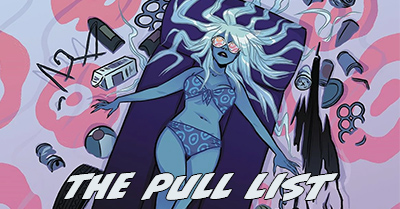
Artwork by Becky Cloonan.
Here’s The Pull List for the 7th of March, 2018. New adds to the pull list are marked with *; dropped titles are marked with #.
- DC Comics
- Batman #42
- * Deathstroke #29
- Exit Stage Left: The Snagglepuss Chronicles #3
- Justice League #40
- * Shade, The Changing Woman #1
- Superman #42
- Image Comics
- * Elsewhere #5
- *# Gideon Falls #1
- * Oblivion Song #1
- * Prism Stalker #1
- Marvel Comics
- * Avengers – Back to Basics #1
- Avengers #683
- Black Bolt #11
- Captain America #699
- Doctor Strange – Damnation #2
- Hawkeye #16
- Iceman #11
- Infinity Countdown #1
- Rise of the Black Panther #3
- Rogue & Gambit #3
- Spider-Man #238
- Venom #163
- X-Men: Gold #23
- X-Men: Red #2
- Smaller Publishers:
Aftershock Comics, Boom! Studios, Dark Horse, Humanoids, IDW Publishing, Oni Press- *# The Ballad of Sang #1, Oni Press
- * Dodge City #1, Boom! Studios
- * Exo #1-3, Humanoids
- Giant Days #36, Boom! Studios
- * Highest House #1, IDW Publishing
- Incognegro – Renaissance #2, Dark Horse
- Mech Cadet Yu #7, Boom! Studios
- # Monstro Mechanica #4, Aftershock Comics
- *# The Spider King #1, IDW Publishing
Before we begin, a reminder that 2.5 stars on my rating scale is an average comic book! It should be my most-assigned score, but I tend to err on thinking average comics are good (confusing, I know), so 3 stars is the peak of my very distributed bell curve of ratings.
That means a 2/5 comic is not bad. That’s my rating for “uneven.” So, don’t freak out and assume a comic book is terrible because it has 2 stars. “Bad” and “Terrible” are 1/5 and .5/5, respectively, and I’ve only given those scores to 2.35% of the comics I’ve read so far this year.![]()
Picks of the Pull
Big Two (Marvel/DC) Pick of the Week:
Infinity Countdown (2018) #1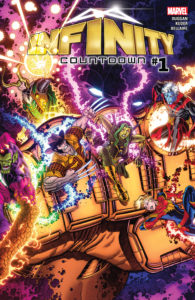
![]() This galaxy-spanning series is ecstatic – maybe the first time I’ve felt like the comics incarnation of Guardians of the Galaxy has resembled the tone of movie since the first film was released.
This galaxy-spanning series is ecstatic – maybe the first time I’ve felt like the comics incarnation of Guardians of the Galaxy has resembled the tone of movie since the first film was released.
This book is built on a year of Guardians plot, but it could not possibly be more inviting to a new reader. All of the action is massive, all of the jokes land, and Aaron Kuder’s style of subtle figures paired with ultra detail is the perfect match for big space blowouts. It’s definitely the first time I’ve ever liked Drax, and the issue is full of amazing moments for Groot.
The Guardians have split their attention between a showdown with the murderous Gardener and defending a massive Infinity Stone along with the Nova Corps. Drax and the Corps start out faring better defending the stone than the rest of the assembled Guardians do agains The Gardener, but as both fights wear on the balance begins to tip.
With the [hugely shocking spoiler] scene on Earth that ends this issue, I understand why Duggan got this story upgraded from being just a Guardians story arc to a universe-wide event. He’s a writer who has been in Marvel’s big leagues for a few years now, and it’s terrific to see him writing an event that touches so many of Marvel’s big franchises without needlessly interfering with their ongoing titles.
I am absolutely subscribed to Infinite Countdown from this point forward, and it has moved Duggan’s Guardians run even further up my “to-read” list.
(Why in heaven’s name would you put a Nick Bradshaw cover on a book with interiors by Aaron Kuder and Mike Deodato? It makes no sense to me whatsoever.)![]()
Small-Pub Pick of the Week:
Exo (2017) Hardcover AKA #1-3, Humanoids
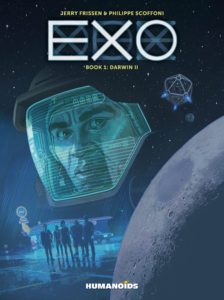
![]() This is the first English translation of this work, originally released as three French graphic albums and here released by Humanoids as three digital issues or a single hardcover.
This is the first English translation of this work, originally released as three French graphic albums and here released by Humanoids as three digital issues or a single hardcover.
Exo is a sci-fi motion picture waiting to be optioned. It combines two seemingly separate plots into one perfectly tense story – one of a NASA scientist on Earth, the other of a military strike force on the moon.
John Koenig is a perfectly average scientist who happens to have located a potentially habitable planet in another solar system and tasked a probe to fly its way. His announcement makes for a sleepy press conference, since any potential findings from the probe are almost two years away. The discovery is just another day at the office for Koenig – he goes for a routine physical afterward, and the heads into LA to retrieve his adult daughter, who calls him John.
Meanwhile, a projectile arcs from the moon to Earth, shattering part of an International Space Station en route to crashing into a field in Colorado before it starts to… branch out. Unfortunately, one of its findings is a schizophrenia man named Charles, who it is unable to control.
As Charles’s new crew seeks John, the military responds to the projectile by putting boots on the lunar ground – but they aren’t ready for what they might find there.
That describes just a sliver of the first 40 pages of this 120 page graphic novel, and it doesn’t even include the drug trip!
Exo has the same third act struggles as any massive sci-fi plot, but the tension that proceeds it is makes it worth a read. Even if a lot of the story draws from familiar tropes, it has the brash inventiveness to combine them in a way that we all hope to see from sci-fi films (think: Arrival).![]()
DC Comics
Batman (2016) #42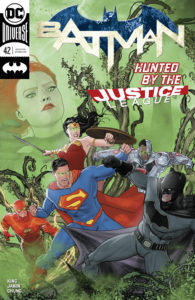
![]() It’s the second issue of “Everyone Loves Ivy,” with Batman and Catwoman seemingly the only two human beings in all creation to not be held under the sway of Poison Ivy.
It’s the second issue of “Everyone Loves Ivy,” with Batman and Catwoman seemingly the only two human beings in all creation to not be held under the sway of Poison Ivy.
So many times in these “take over the world” plots we only get the bits where people bash on each other. It’s a joy to see Catwoman and Batman enjoying the quiet while they plot their next move. I’m in love with this sassy version of Catwoman who is raging against Ivy’s world domination while she and Batman explore a Gotham City that speaks only in Ivy’s voice. Catwoman has a hilarious monologue (meant as much for Bruce as Ivy) about a wedding where Ivy is the sole officiant, guest, and vendor – made even more funny by Batman ordering their fast food dinner and silently eating while she raves.
(Their first dance? “The sound of wind rustling through leaves.”)
Janin’s art here is spectacular, as always – especially early shots of Superman gazing down at Bruce and Selina as an always-open eye, and later the confrontation atop a sky-scraper.
At the same time, this more of Tom King delighting in writing nonsensical domestic moments in the middle of superheroism. It’s a trick that is seriously wearing thin for me because it doesn’t allow him to dissect the domestic moments with incisiveness as he did in Vision. It’s hard to tell which moments here are Bruce playing a strategic long game and which are him being trapped by Ivy. As with “War of Jokes and Riddles,” King is so busy being clever that he’s not leaving any room for the reader’s imagination. ![]()
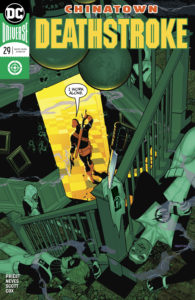 Deathstroke (2016) #29
Deathstroke (2016) #29
![]() Finally, I’m caught up with Christopher Priest’s Deathstroke! Priest has been creating the pinnacle of highwire Big Two comics here with a dazzlingly complex run, 99% of which has had stellar artwork – as this issue does, from Diogenes Neves.
Finally, I’m caught up with Christopher Priest’s Deathstroke! Priest has been creating the pinnacle of highwire Big Two comics here with a dazzlingly complex run, 99% of which has had stellar artwork – as this issue does, from Diogenes Neves.
This issue demands you read it at a break-neck speed as it resolves a surprising amount of this title’s many, many, many ongoing plot points. Here they all come home to roost. Slade Wilson’s many deceptions and usurious behavior sees him stripped of everything – his powers, his suit, and his family. Meanwhile his daughter finally realizes she’s been being used for months and surrenders herself to death – only to find a surprising outcome.
The result is Slade Wilson at one of his lowest points – broken and abandoned, his newfound repentance as shattered as his body.
This is not a book you can just pick up cold, and even if you’ve been following it closely you might need a diagram to keep track of all of the double-crosses by the four living members of the Wilson clan. Luckily, the book is fond of leaving readers many hints in editorial captions, even when they refer to the prior issue! With Priest, it’s important to determine the difference between newly-introduced developments and reminders of past continuity.
If you’ve been waiting to read it all in one go, now is the time to start, as it seems the next six issues will be a much smaller, more personal affair between Deathstroke and Batman.![]()
Justice League (2016) #40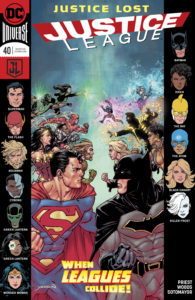
![]() Christopher Priest makes a very rare and very subtle misstep in the premise of this issue, which spoils the tense proceedings for me.
Christopher Priest makes a very rare and very subtle misstep in the premise of this issue, which spoils the tense proceedings for me.
Early on in this do-or-die drama on the Watchtower, Superman says the League cannot be concerned with public perception, but that’s coming from Clark – a journalist. Superman is never that pragmatic at the expense of his heart, and his oddly stoic behavior in this deadly race against the clock really grated on me. There are ways to portray the big seven League characters as hopelessly out of touch, but making Superman the character who lacks empathy isn’t one of them.
The art briefly takes a muddy turn at the beginning of the locked room ordeal on the Watchtower, but it quickly turns around from there to something strong. Ultimately this is a lot of characters to juggle with a ton of powers, and it requires some suspension of disbelief to go along with them all being in danger trapped on the Watchtower.
Ultimately, it’s another super science-based plot that saves them. This touches on some interesting philosophy of morality for a Justice League comic. Is (no-longer-Killer) Frost worth saving if her spot could go to Batman or Wonder Woman? All of the classic JL heroes are altrustic, but some (Aquaman) may be too pragmatic to sacrifice a hero that can save the earth over someone who can only effect local change.
Ultimately this feels like a bit of fluff in the larger plot of The Fan, but it’s still an enjoyable JL comic.
Superman (2016) #42
![]() This issue is heavily focused on our Super Son. It’s also a challenging read thanks to an opening in Bizarro World, where every descriptive word in every sentence must be reversed to understand the real meaning of a phrase. That gives way to Jon hanging out on Cathy’s farm back in their small town before he realizes he’s late getting home for chores. I wasn’t a fan of reading so much Bizarro dialog, but otherwise this issue is just fine.
This issue is heavily focused on our Super Son. It’s also a challenging read thanks to an opening in Bizarro World, where every descriptive word in every sentence must be reversed to understand the real meaning of a phrase. That gives way to Jon hanging out on Cathy’s farm back in their small town before he realizes he’s late getting home for chores. I wasn’t a fan of reading so much Bizarro dialog, but otherwise this issue is just fine.
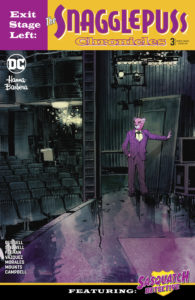 Exit Stage Left: The Snagglepuss Chronicles (2018) #3
Exit Stage Left: The Snagglepuss Chronicles (2018) #3
![]() With this third issue, I think I understand better what Snagglepuss is seeking to achieve. It’s not only a book about McCarthyism and being in the closet in the 50s. It’s about the entire social fabric of the 50s, giving us little glimpses behind the scenes of the events we know from media history.
With this third issue, I think I understand better what Snagglepuss is seeking to achieve. It’s not only a book about McCarthyism and being in the closet in the 50s. It’s about the entire social fabric of the 50s, giving us little glimpses behind the scenes of the events we know from media history.
In this issue, we glimpse at the love triangle between Marylin Monroe, Joe Dimaggio, and Arthur Miller. Snagglepuss ultimately has very little to do with it, but it gives us a glimpse into the difference between famous men and woman in this era, and also an idea about the difference between a star and an actor. (By Snagglepuss’s definition, DiMaggio is the actor, not the star).
“A star shows people who they’d wish to be, an actor shows them what they are.”
With my view of the series revised I appreciate it a bit more, but I think the episodic nature of these little vignettes take away from the narrative heft the first issue established. We get nothing directly about McCarthyism here, save for a stray mention of Snagglepuss’s requested appearance before the commission. While the Marilyn stuff (and an introduction to Stonewall’s humble beginnings) was strong, I think the A-plot of the Red Scare deserves to remain at the fore.
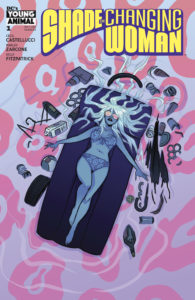 Shade, The Changing Woman (2018) #1
Shade, The Changing Woman (2018) #1
![]() If you are reading this book and thinking, “This may be total nonsense!,” you are not alone. Even fresh off of reading the first volume in its entirety, elements of the first half of this issue just barely made sense to me.
If you are reading this book and thinking, “This may be total nonsense!,” you are not alone. Even fresh off of reading the first volume in its entirety, elements of the first half of this issue just barely made sense to me.
Where exactly do you pick up with an alien refugee wearing a coat of madness who let both of her bodies die and now has a new human form?
I think you have to begin where this issue does – in unsettling, uncomfortable madness that makes you question if you’re even interested in this book anymore. Then, just when it feels like this will be too weird to follow, reality snaps back into focus, as does Shade – who just wants to continue living her life, whatever that is. It’s a terrific narrative choice, as is the choice to reunite Shade’s with her BFF River, who is one of the best parts of this book.
I’ve always heard people describe the journey’s that psychedelic authors like Morrison and Moore have taken them on, but this might truly be the first time I’m experiencing it myself. Even when I hate or don’t understand this book, it’s taking me on a trip.![]()
Image Comics
Elsewhere (2017) #5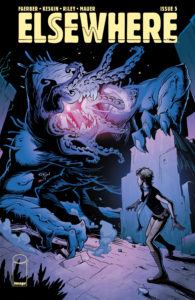
![]() This is Elsewhere‘s first issue after a four month hiatus, and it immediately feels as though the already good-looking art had gotten an upgrade. Maybe it’s just a tonal shift from the first arc, but everything feels bit brighter and cleaner here.
This is Elsewhere‘s first issue after a four month hiatus, and it immediately feels as though the already good-looking art had gotten an upgrade. Maybe it’s just a tonal shift from the first arc, but everything feels bit brighter and cleaner here.
Elsewhere is the story of the lost and forgotten travelers of Earth who arrive in a fantastical other world that feels a lot like Avatar’s Pandora, complete with floating mountain ranges. The tricky part is that this world seems to be unmoored in time compared to our own, so that DB Cooper can arrive from 1971 a hair before Amelia Earhart from 1937.
This issue leaves a few threads annoyingly untied from the big finish of the first arc – it doesn’t explicitly comment on the wounds suffered at the end of the last arc, it never address their mole on the inside of Kagan’s castle, and it’s a bit blithe about whereCooper and Kagan got off to (though one of those is revealed in short order).
Yet, to me that just emphasizes the Saturday Morning Cartoon quality of this series – you can tune in any time and not miss a beat. The last page cliffhanger here is a real doozy – as big as the one at the end of the first issue. This series is a charm and I’m sure to keep reading.
Something I’ve been under-appreciating about this series to this point is how plain the colors are. There’s not a lot of gradient trickery being used by colorist Ron Riley to dress up Sumeyye Kesgin’s faces into something more three-dimensional. Amelia’s flesh tone is usually just two colors, with a very slight lighting effect to imply the plains of her face. That’s what gives this book its cel-animated quality. ![]()
Gideon Falls (2018) #1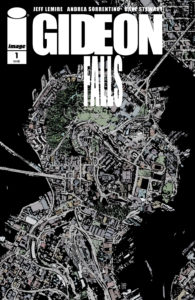
![]() I will confess my bias to this comic up front: I haven’t been a fan of the Jeff Lemire and Andrea Sorrentino combination on either Green Arrow or Old Man Logan. I think Sorrentino’s dark filter on photorealism allows Lemire to gravitate to his sparsest qualities as a storyteller, which in turn invites Sorrentino to spend a lot of time playing with layouts. As a result, I’ve found their issues to often be quick, unsatisfying reads.
I will confess my bias to this comic up front: I haven’t been a fan of the Jeff Lemire and Andrea Sorrentino combination on either Green Arrow or Old Man Logan. I think Sorrentino’s dark filter on photorealism allows Lemire to gravitate to his sparsest qualities as a storyteller, which in turn invites Sorrentino to spend a lot of time playing with layouts. As a result, I’ve found their issues to often be quick, unsatisfying reads.
Despite that, I read this comic book. Why? Just to see if a stopped clock would be right this one time?
For me, it was more about what Lemire outlines in his afterward. This is an idea that has been with him for his entire career, and one that kept itching at both his and Sorrentino’s brain all through their run at Marvel. It was a story that demanded to be told, and that is the sort of book I want to read from Jeff Lemire – not a story he pitched on to a big publisher.
Unfortunately, Lemire and Sorrentino managed to slow down my reading of Gideon Falls in the worst possible way: the lettering by Steve Wands is challenging and at points completely unreadable without squinting.
I’m not sure what you’d pick suck a finnicky, thin-stroked, rounded font as the primary font in a comic, even if it was your own hand-lettering. It’s incredibly tiresome – my eyes were over it within two pages. The splines of the letters are creaky and crooked, sometimes not quite connecting at the top of a T and overshooting each other in the cup of a V or a Y. It gives you pause points in every sentence and sometimes every word where your eyes linger to make sure they aren’t misinterpreting their input.
That would be fine for a certain character’s voice or for a specific style of narration, but it’s the lettering choice for every word of text throughout the entire issue. Sometimes the font appears unbounded and reversed out as white on backgrounds or, worse still, reversed out as white on black in caption boxes.
Also, why the random color changes in the balloons to yellow or lavender? It’s so distracting!
In all honestly, I’m not entirely sure what the story was about because I had so much trouble reading most of it. Maybe this is the one true Lemire and Sorrentino masterpiece I’ve been waiting for! I certainly love my transgressive religious fiction, and the theme of a put-upon priest deployed against his will to replace his deceased brethren in this small town is squarely in my satisfaction zone.
I’ll take a peak at the previews of later issues to see if the lettering choices start making a bit more sense; it would be a real pity to see an entire ongoing series saddled with this font styling.
![]()
Oblivion Song (2018) #1 (Skybound)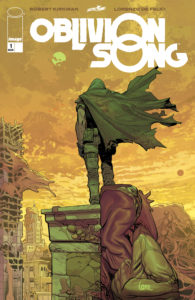
![]() In the continued spirit of confessional honesty from that last entry, you should know that I have a rocky relationship with comics from Robert Kirkman, creator of Walking Dead and the recently concluded Invincible.
In the continued spirit of confessional honesty from that last entry, you should know that I have a rocky relationship with comics from Robert Kirkman, creator of Walking Dead and the recently concluded Invincible.
Kirkman is an imaginative, forward-thinking author who clearly traffics in fascinating concepts, but I often find his writing too mean-spirited and cynical for my tastes with an unavoidable streak of toxic masculinity that isn’t always intentional.
This first issue does a fascinating thing: it introduces a massive, world-altering sci-fi concept without lingering on it.
There is an alternate dimension that swallowed up the better part of a US city, leaving behind remnants of its fantastic bestiary. Now, a decade later, search parties into the dimension are no longer funded, and it’s up to three members of a rogue lab to continue the search for missing people there.
Most books wouldn’t be able to resist talking about the dimension, when the dimension arrived, how the dimensional travel works, and more. Kirkman understands that a first issue doesn’t require any of that explanation. As in Walking Dead, he ignores the potential world-building distractions to focus on the people.
Nathan is the weary adventurer who is insistent on bringing more people back, and not just because his brother is still among the missing. He applies for funding by day and under cover of night stubbornly chisels the names of the newly-found off of a Vietnam-style memorial wall. The issue stays tightly focused on him and his two lab partners, as well as on the pair of people he rescues from that other place. There is a hint of a question of how people have survived there for this long and what sort of society they might have formed to pull us into the next issue.
While this isn’t my favorite recent Image debut, it’s certainly comics craft done well. I think Kirkman was in his finest form and I love the wild, jangly artwork by Lorezo de Felici and colorist Annalisa Leoni. It’s amazing to hear that they and Kirkman already have 12 issues of the series wrapped. No delays for this one!![]()
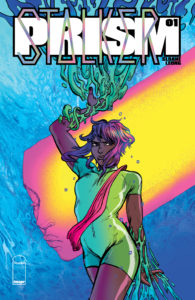 Prism Stalker (2018) #1
Prism Stalker (2018) #1
![]() A singular effort by writer/artist Sloane Leong with bold lettering from Ariana Maher.
A singular effort by writer/artist Sloane Leong with bold lettering from Ariana Maher.
Leong’s art is a combination of anatomically precise alien biology and wild psychedelia, with a sickening orange and green color scheme conveying the unease of the slimy place the human characters now call home. Our protagonist, Vep, is part of a group of displaced refugees, farming delicious alien eggs in exchange for their room and board on this strange world. Vep aches to understand more, both of the world and of the world and family she lost.
There were points where the colors were a bit too unsubtle for me on faces and flesh tones, and some of the three-quarter profile faces look slightly lumpy and disproportioned.
This comic is full to the brim with massively inventive themes, but the storytelling was a bit oblique and I think the execution of the artwork is just a bit below the par I expect from an Image series. It feels like a upper-middle-quality web comic in an infinite sea of competitors. The premise is interesting enough to be worth picking up another issue, but that will be with specific hopes of tightened art quality.![]()
Marvel Comics
Avengers (2017) #683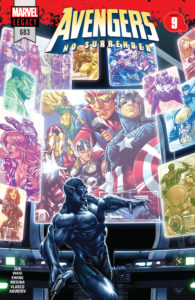
![]() This is the first time we’re changing pencilers after just one issue during “No Surrender,” and it’s a disappointment to switch so quickly after the strong artwork in the last installment from Sean Izaaske even if Paco Medina is typically one of my favorites at Marvel.
This is the first time we’re changing pencilers after just one issue during “No Surrender,” and it’s a disappointment to switch so quickly after the strong artwork in the last installment from Sean Izaaske even if Paco Medina is typically one of my favorites at Marvel.
The more disappointing art change is to Jesus Aburtove on colors, breaking the streak of consistency from David Curiel. It breaks up the consistent look and feel this book has maintained across four line artists and eight issues.
This chapter feels like a “meanwhile” to the main story out on the battlefield, as Beast and Wasp homage my favorite Avengers issue (Avengers #93 – “Journey To The Center of the Android”) to shrink into Jarvis’s brain to deliver an antidote to his odd malady. I enjoyed seeing an agile, verbose Hank McCoy in action here, and his quick realization that Nadia Pym as the Wasp is one of the all-time best Avengers was quite touching.
Ultimately, this comic was pretty average – there wasn’t a lot of narrative heft behind the strange pink ghosts threatening the hospital, and the reappearance of Vector at the close of the issue felt like it was missing a sinister beat.
![]()
Avengers – Back to Basics (2018) #1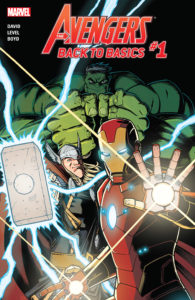
![]() This is a low-grade Avengers adventure from veteran Peter David.
This is a low-grade Avengers adventure from veteran Peter David.
The framing concept of this book was Kamala Khan getting to watch some legendary Avengers action in virtual reality, but then the book ignores the story (and comedy) potential for her to be inserting herself into these scenes of a vintage struggle against Loki to add her commentary on the anachronism of this core of all-boy Avengers (all of whom are currently dead or missing).
Without that level of irony, there’s not a lot to this book – it’s ostensibly about Ragnarok, but as an audience we already know it’s not going to be very important since Kamala is viewing a long-past exploit.![]()
Black Bolt (2017) #10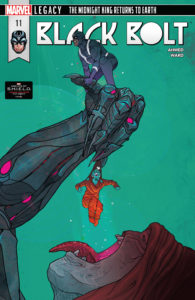
![]() This penultimate issue starts drawing together all of the plot strings of this series, and it does nicely in incorporating elements of each arc to pay off the entire story rather than just pit Black Bolt against his jailer.
This penultimate issue starts drawing together all of the plot strings of this series, and it does nicely in incorporating elements of each arc to pay off the entire story rather than just pit Black Bolt against his jailer.
It was one thing for The Jailer to be all-powerful in his mysterious space prison, but here I felt his powers were much too intangible – especially with a B-plot that involved wondering the Astral Halls of Black Bolt’s mind.
However, Christian Ward continues to deliver some of the most stunning (and most structured) art I’ve seen from him to date, and somehow this book had turned Titania into a character I crave on every page. Her C-plot side mission with Lockjaw turns out to be the most rewarding element of this issue.![]()
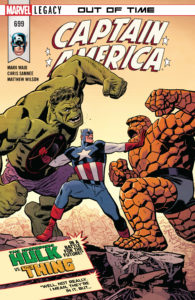 Captain America (2017) #699
Captain America (2017) #699
![]() This “Cap fights in the future” plot is a total loss, despite this installment tugging on our heartstrings with a brilliant appearance from the Thing.
This “Cap fights in the future” plot is a total loss, despite this installment tugging on our heartstrings with a brilliant appearance from the Thing.
Samnee’s version of Ben Grimm is sheer majesty – he’s my least favorite member of The Fantastic Four, but this vision of him makes me want a Samnee-drawn Thing book right now.
Otherwise, this issue is inert. Cap triumphs against the despotic ruler of future America seemingly out of sheer will, freeing an entire country that has no remaining ruling class to reform a government.
I’m sure that will lead to some tidy morals from Cap next issue before he is shuttled back to the present, but I can’t help but think that a present day version of this arc where perhaps just a single city was under Rampart’s control might have been a lot more powerful than a meaningless alternate future we are sure Cap will be promptly returned from.![]()
Doctor Strange – Damnation (2018) #2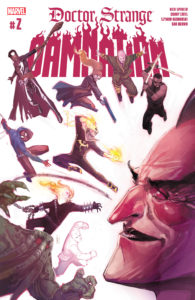
![]() This issue is another terrific and terrifically fun episode of Damnation, which feels more like an event than a lot of Marvel’s major efforts in the past few years (which is ironic, since this springs entirely from the aftermath of Secret Empire, which was never this fun).
This issue is another terrific and terrifically fun episode of Damnation, which feels more like an event than a lot of Marvel’s major efforts in the past few years (which is ironic, since this springs entirely from the aftermath of Secret Empire, which was never this fun).
This issue feels like it’s much more in Nick Spencer’s bickering tone than Donny Cates’ drier humor, as Wong assembles a Magic Avengers team of unlikely suspects whose ongoing series I WOULD SO TOTALLY BUY.
That makes a lot of this issue little bits of recruiting and planning (of course Wong has folders) rather than action, but when we do get action back in Las Vegas is fiery and a lot of fun thanks to another incredible issue of art from Rod Reis. This main story is so good that it makes me want to pick up the handful of tie-ins – a pretty big victory!
![]()
Hawkeye (2017) #16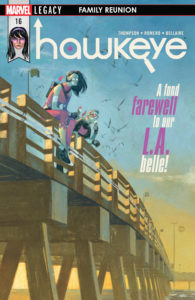
![]() This issue is a somewhat-rushed conclusion for our beloved Kate Bishop. It doesn’t really answer many of the questions of her run or provide satisfying closure – just more questions.
This issue is a somewhat-rushed conclusion for our beloved Kate Bishop. It doesn’t really answer many of the questions of her run or provide satisfying closure – just more questions.
What does have is another big Hawkeye(s) vs Everybody fight sequence, but this one is just a crash of arrows against bodies without the narrative resonance and humor that the past few crowd scenes have had.
As Kate resolves her conflict with new blue-haired nemesis Eden, we get a way big reveal about one of Kate’s friends and another totally huge about her family – both massive cliffhangers! I think that has good implications for the future of Kelly Thompson telling stories with Kate, as does the tickler at the end of the issue that Thompson and Bishop will be back this August.
This has still got its moments, including a genuinely emotional moment with Eden, but it feels like Kelly Thompson decided to wrap this up as simply as possible to hang on biggest revelations it could provide for later.
Iceman (2017) #11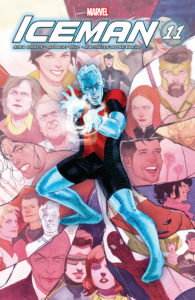
![]()
Was the final issue of Iceman… the best X-Men book of the week? YES IT WAS, and I’m as surprised as you are!
Writer Sina Grace and artist Robert Gill (with Grace on inks!!!) took this series out on a high note with a self-contained X-Men story that would fit in any era. It featured a capable, confident Bobby investigating a disturbance on his parent’s sleepy suburban street with a hilariously wry turn from Rictor as his sidekick (after the two go on a fizzled lunch date).
The present day tale was interspersed with key memories from Bobby’s life. While some of them were a bit to on the nose with the “mutant = gay” metaphor and others felt like they could have made a bit more sense, the device worked, as did the lightweight aping of the pencils of each period.
In fact, the art on this issue may have been the best of the entire run – Grace on inks gave Gill’s work a pleasing roughness, and Rachelle Rosenberg made the most of the pink colors of the mutant power that was pitted against Bobby’s icy blues.
As it turns out, this was the Iceman comic we needed all along – one that commented on his sexuality, but focused on him being his own positive version of a hero versus combatting the negative ones like Juggernaut and Daken.
I’m happy to see this end on a high note.
Rise of the Black Panther (2018) #3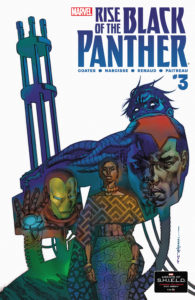
![]() This is a perfect Black Panther comic book. It effortlessly marries T’Challa’s Silver Age history with the themes of his film (and the wider MCU) and of Ta-Nehesi Coates’s modern run.
This is a perfect Black Panther comic book. It effortlessly marries T’Challa’s Silver Age history with the themes of his film (and the wider MCU) and of Ta-Nehesi Coates’s modern run.
Writer Evan Narcisse turns in his third masterful script in a row, full of political conversations and technical digressions that never drag. Yet, all that would mean nothing without Paul Renaud turning in a peerless performance on art with Stephane Paitreau on colors. Their pages are textured and they have an inner glow to them, as if this comic is being lit from behind rather than imitating light on a two-dimensional plane.
This forgotten tale of Wakanda falls just after the Fantastic Four’s fateful visit to the country, but before the Panther joins the Avengers. It follows the first time Wakanda ever invited representatives of foreign governments inside of its borders, which quickly gains the attention of SHIELD and Tony Stark, as well as some more unsavory characters.
As with the past two chapters, you don’t need any pre-existing knowledge to enjoy this issue – although, it will definitely appeal to fans of the MCU thanks to an appearance by Shuri and one other surprising character.![]()
Rogue & Gambit (2018) #3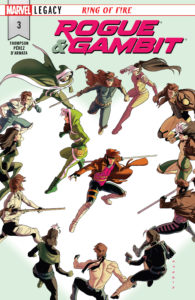
![]()
I love Kelly Thompson’s writing and Rogue is one of my favorite characters, but it might be time to call a spade a spade here.
This series is continuity porn, plain and simple. It’s the kind of comic that X-Men books aren’t usually but everyone accuses them of being.
You have to be primed with specific points in Rogue and Gambits history to get the full brunt of this plot. Even though it references them at length, it’s just not the same as having read it already and having carried around the same baggage as these characters have.
The best part of this book is artist Pere Perez, who draws an outstanding fight scene full of multiple Rogues and multiple Gambits that is mostly easy to track (plus a scintillating scene of our stars in their bathing suits).
While any discontinuity from the last issue is obviously explained by the drain on memories and powers in this issue, the story itself may not be very interesting to all but the most devoted fans of Rogue and Gambit. ![]()
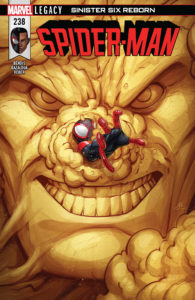 Spider-Man (2016) #238
Spider-Man (2016) #238
![]() After a lengthy amount of set-up, we finally get to the Helicarrier heist in this issue, and it’s pretty thrilling stuff.
After a lengthy amount of set-up, we finally get to the Helicarrier heist in this issue, and it’s pretty thrilling stuff.
Artist Oscar Bazaldua and colorist Brian Reber have really leveled up their game here with some beautifully clean artwork that’s in the same league as Kim Jacinto and Pepe Laraz on Avengers.
The sheer kinetic fun of it is repeatedly interrupted by Brian Bendis’s script. While it’s not as overly-wordy as his normal part, there are several points in the issue where the constant repartee just stopped making sense for a balloon or two.
It’s not a critical error, but it’s distracting in a comic that otherwise flows this nicely and looks so beautiful. As is the trend for this series, we have a totally irrelevant and slightly cartoonish cover obscuring what the story inside actually is and looks like.
Venom (2017) #163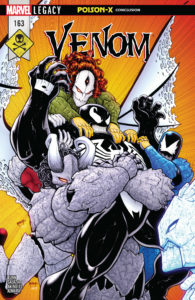
![]() This title brings the Poison-X crossover to a conclusion in a workmanlike fashion, ticking through plot points like they’re a grocery list.
This title brings the Poison-X crossover to a conclusion in a workmanlike fashion, ticking through plot points like they’re a grocery list.
“Free Starjammers. Have a fight. Escape ship.”
There is no comics magic happening in the middle – no great panels or memorable moments. Even the loss of a teammate is played flatly, with no one seeming to take it seriously until the closing panels of the comic even though there is so much material to mine – not only from the relationships, but from the idea that time must bring the teammate back, somehow … or will it?
There are so many weirdly clumsy turns of phrase I would attribute to a small press comic … “sorry friend … turn their backs on friends or enemies,” “these tunnels” about a single one-off tunnel – it’s as if this issue didn’t have an editor!
Altogether, it’s an unimpressive end to a dull story that peaked in its second and third installments, when at least it could play on Star Wars Catina scene nostalgia.![]()
X-Men: Gold (2017) #23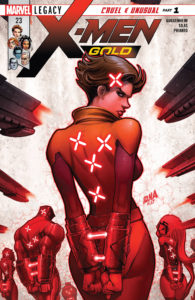
![]() Credit where it’s due to writer Marc Guggenheim. Tthe idea of the X-Men in a general prison population where they aren’t being specifically discriminated against – just trying to follow the rules – is a relatively fresh plot.
Credit where it’s due to writer Marc Guggenheim. Tthe idea of the X-Men in a general prison population where they aren’t being specifically discriminated against – just trying to follow the rules – is a relatively fresh plot.
Unfortunately, he does nothing with it. Nightcrawler and Colossus win a fight. Storm, Rachel, and Kitty walk around in a “pretty girls” pack. We don’t get moments of Ororo or Rachel reflecting on being jailed, or Kitty moralizing about them serving their time. It’s a completely flat script slightly improved by the pleasing angular quality of the artwork, which gives the characters a sense of swiftness.
That’s the hallmark of this run – good ideas we haven’t seen before from the X-Men executed in a bland way with interchangeable characters.
For me, this is summed up by Iceman coming back to the team to lead it alongside Rogue. On one hand, they are two of the most senior X-Men, and just as Rogue began consistently leading in the 00s, it really feels like Iceman’s turn these days. On the minus side, Iceman’s Danger Room demeanor as a tough guy didn’t really fit – especially when he wasn’t leading a team of noviced (except for Ink). Similarly, his equating accepting newbie Pyro to the school with him being an X-Man was somewhat puzzling.
Plus, a line about Calypso being unable to.. find a puppy in prison?
The whole thing is puzzling. ![]()
X-Men: Red (2018) #2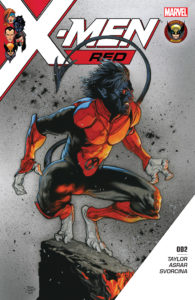
![]() X-Men Red is good, but there’s something holding it back from GREAT and I cannot put my finger on what it is in specific.
X-Men Red is good, but there’s something holding it back from GREAT and I cannot put my finger on what it is in specific.
It might not be something specific. Asrar’s artwork continues to be unremarkable – some strong panels, but just as many with gawky, misshapen characters. He often makes adult Jean look as tiny as her teen counterpart.
Yet, even if his figurework is leaving something to be desired, his storytelling is strong – he’s picking the right shots and showing the right motion. His full page spread of the prison break is incredible. That to me says that this is perhaps the case of needing an inking or a bad colorist fit, rather than an artist simply not being up to the task – because his composition is strong throughout.
Then there is Taylor’s approach to this story. We started out with a aspirational Jean Grey, but we immediately got rocked back to her being hated and feared in temporary exile in Wakanda. Jean plans a fine prison break, but I think she’s more compelling for her empathy than her strategy.
Also, while Trinary’s robin hood act of single-handedly fixing India’s pay gap is admirable, it’s still a crime – which makes the muddiness of her captivity and her breakout a bigger moral challenge than it needs to be. That’s not to say there is nothing entertaining about this script. We get Jean being a psychicic first and telekinetic second, which a lot of past writers have ignored.
(The cover by Travis Charest is gorgeous, but a bearded, fierce-looking Nightcrawler is completely off-model and irrelevant to this issue.)![]()
Smaller Publishers:
Aftershock Comics, Boom! Studios, Humanoids, IDW Publishing, Oni Press
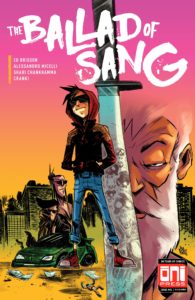 The Ballad of Sang (2018) #1, Oni Press
The Ballad of Sang (2018) #1, Oni Press
![]() A bloody, scratchy, scrappy comic about a young, mute assassin with violent impulse control problems. When he unintentionally kills his mark, he brings the full force of the mob down on him and his master.
A bloody, scratchy, scrappy comic about a young, mute assassin with violent impulse control problems. When he unintentionally kills his mark, he brings the full force of the mob down on him and his master.
I’m not a particular fan of bloody comics – not because I dislike gore, but because it doesn’t particularly thrill me, and this is pretty much all dismemberments and disembowlings with nothing to tie them together but a revenge plot.
I know that many of you probably perk up at the thought of that, and if you do: CHECK THIS OUT!![]()
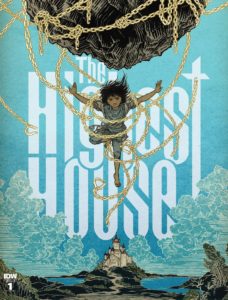 Highest House (2018) #1, IDW Publishing
Highest House (2018) #1, IDW Publishing
![]() Any comic by the Unwritten team of Mikey Carey and Peter Gross has a very high pedigree to live up to for me. Highest House is as finely-crafted as you’d expect, but I’m not sure of what to think of the story.
Any comic by the Unwritten team of Mikey Carey and Peter Gross has a very high pedigree to live up to for me. Highest House is as finely-crafted as you’d expect, but I’m not sure of what to think of the story.
It’s a story about slaves – buying, trading, and training them – in a Medieval society. Anyone can be a slave, because every family has its least-useful mouth to feed and every jailer has their recidivist. There is some magic in this world that workships a goddess and believes in the supernatural, yet to witness the actual use of magic is surprising (or, I should say, the harnessing of magic, since it seems to exist for anyone to use).
The slaving aspect of the story is deeply upsetting – not because of the treatment of the slaves (yet) but because of how heartlessly they are appraised and purchased. We follow Moth, a wheezing young boy who has some innate gift recognized by the slaver, but who will in the meantime be patching roofs.
This series is replete with fascinating mythology, but I am no fan of “misery porn” of watching the underclasses suffer and people exploited by their masters. I am willing to stick around for a few issues due to my allegiance to Carey and Gross to see what develops.![]()
Dodge City (2018) #1, Boom! Studios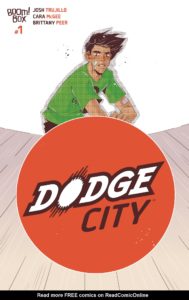
![]() This is a book about one very serious dodgeball game where the winning team is not ever in question.
This is a book about one very serious dodgeball game where the winning team is not ever in question.
It’s a serious game because Dodge City is serious about dodgeball. It’s never in question because the Jazz Pandas are a terrible team with little talent (well, except for one guy) and less cohesion. They mostly have to forfeit their games, to they are happy to pick up a new player in Tomas, even if he has no idea what the rules of the game are.
This comic book does one thing very well, which is actually name and define its cast of characters right away. There are still many relationship nuances for us to figure out, but it’s nice to be introduced to everyone’s names without hunting an entire issue for context clues.
If fighting scenes are hard to choreograph, then dodgeball scenes are probably even harder, and there are a few moments in this issue where between the script and the action I’m not entirely certain what’s going on in a certain panel.
This issue has a lot of charm, and I love the artwork. I’m interested to see if every issue is a game, or if we get some of the home lives of these characters.![]()
Giant Days (2015) #36, Boom! Studios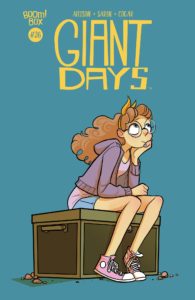
![]() The end of the girls’ second year at University is Giant Days at its peak, and that’s even with typical star Esther relegated to a B-plot.
The end of the girls’ second year at University is Giant Days at its peak, and that’s even with typical star Esther relegated to a B-plot.
The long-awaited resolve of Daisy’s romantic tensions is just as big a catastrophe as you might expect, if not BIGGER. We also get a very charming appearance out of Susan’s father, who has just about every punchline in this issue (except for the ones had by the Bus Drives).
This is brilliantly drawn by Max Sarin. Sarin is never off-model on any character, but this feels like a return to form where we have less whimsical moments and more real life ones.
At the end of the issue, we’re quite suddenly left with a very clean slate heading into Year 3 – none of the girls have major problems they’re battling save for the one that crops up for Daisy on the final page.
It will be interesting to see where Allison takes things next for these young women, but I have renewed confidence that wherever it is it will be great.![]()
Incognegro – Renaissance (2018) #2, Dark Horse / Berger Books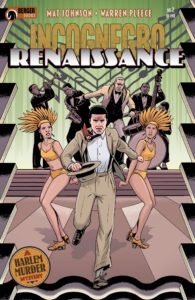
![]() This issue continues the engaging murder mystery from the end of the first issue with more layers of what it means (and doesn’t mean) to be white passing in the Harlem Renaissance.
This issue continues the engaging murder mystery from the end of the first issue with more layers of what it means (and doesn’t mean) to be white passing in the Harlem Renaissance.
While this might not be as dense with jokes and characters as the first issue, I think it’s even more engaging as we settle in for Zane’s mission that is half journalism and half murder investigation.
This issue at once light-hearted and tense, and makes terrific use of the visual medium to layer in information, conflict, and laughter that’s not explicit in the word balloons.
A brief trip into an all-white jazz club is fascinating but not long-lasting, as Zane gets made up to pass as white more completely but then is rebuffed by the central figure in his investigation.![]()
Mech Cadet Yu (2017) #7, Boom! Studios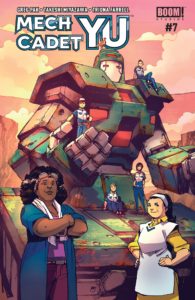
![]() You know this Greg Pak and Takeshi Miyazawa comic book has struck gold when a 3.5 star issue feels like a failure compared to the rest of the run.
You know this Greg Pak and Takeshi Miyazawa comic book has struck gold when a 3.5 star issue feels like a failure compared to the rest of the run.
This issue hand-waves a lot of the developments from last time, having some of the injured characters basically say, “Oh, I got over it.” That would be more annoying if it didn’t lead directly into even bigger intrigue at Central Command, which has been up to a lot more than making just the one man-mad Mech that Park has been driving.
This issue feels like it was an extremely rapid pivot from the academy setting and minor skirmishsd against the Sharg to a bigger, “universe hangs in the balance” sort of plot. Given that this title was extended from a four issue mini-series, it feels like the past two issues were the booster rock that would help launch this story to a much bigger scale.
I like it, but I’m worried that this series will lose the cheerful, YA tone that’s made it such a standout thus far.![]()
Monstro Mechanica (2018) #4
![]() I daresay I’ve enjoyed every panel of artwork from Chris Evenhuis and colorist Sjan Weijers in this cleanly-lined comic about Leonardo Da Vinci’s mechanical man, but the plot does nothing to excite me.
I daresay I’ve enjoyed every panel of artwork from Chris Evenhuis and colorist Sjan Weijers in this cleanly-lined comic about Leonardo Da Vinci’s mechanical man, but the plot does nothing to excite me.
After the most fun issue yet last month where we found ourselves in the midst of a siege, this investigation of its aftermath is totally flat. I understand in concept why the Medici’s are focused on consolidating power and how that puts them slightly at odds with the church, but the script has gone four issues now without managing to convey any sense of urgency about that.
The sole pleasing aspects of this narrative are Da Vinci’s assistant and the Medici’s “moorish nephew,” and neither gets to show much personality here.
I might take another shot at this book in a collect format, but it’s not working for me as a monthly pull.
The Spider King (2018) #1, IDW Publishing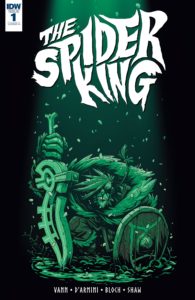
![]() The style of artwork in this “Vikings vs. Aliens” comic is big round figures with geometrical features and noses that look like turnips. They look a bit like illustrated Muppets.
The style of artwork in this “Vikings vs. Aliens” comic is big round figures with geometrical features and noses that look like turnips. They look a bit like illustrated Muppets.
I’ve enjoyed this style on other, sillier books, but I had trouble buying it as a bloody inter-clan conflict, The colors did the art style no favors. The entire world is washed with a muddy orange and brown color cast by day and frosty blue by night that ignores the actual colors of things until the final pages. That gives the artwork a sort of sameish quality that makes it easy to skim past, because there is no visual cue to focus on.
Paired with a rather dull plot of chauvinist Nordic rebellion interrupted by alien invasion, this is a solidly-crafted comic that simply doesn’t hold any special appeal despite its imaginative concept. I think if you enjoy cartoonish viking blood vendettas played out on the stage of a genre mash-up you might dig this, but that’s an awfully specific audience segment.